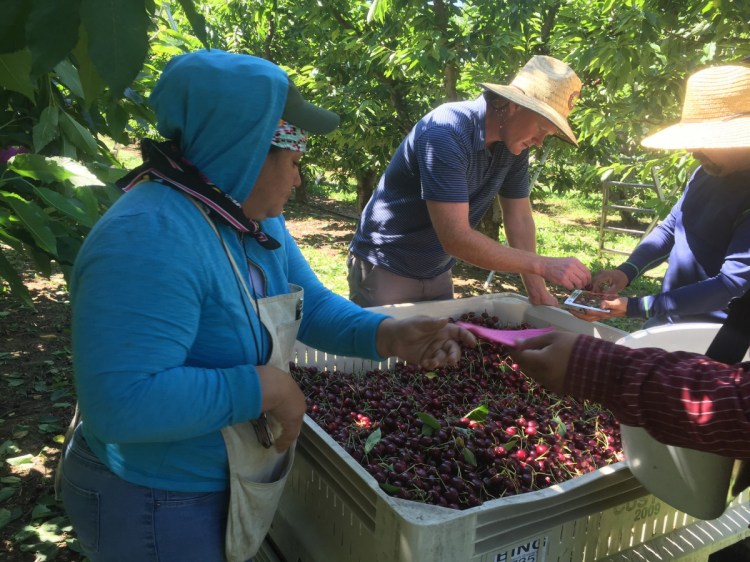It’s nearly apple-picking time in Washington’s Yakima Valley. Cherry season will be around for a few more weeks, and a bounty of other fruits and vegetables are maturing on branches and in fields.
“The orchards are big and beautiful,” said Dan Fazio, executive director of the Washington Farm Labor Association. “The crop looks good.”
Just one problem: A shortage of workers to bring in the harvest.
It has been an issue in Washington and other farm states for several years because fewer U.S. workers want to take agricultural jobs. The primary reason is that farm work is seasonal. For Washington’s iconic crops – apples, cherries and pears – the work lasts less than six months. Construction jobs, on the other hand, generally last longer and pay more.
“If we had 12 months of work, we would have more Americans wanting this job,” said Fazio, whose group provides housing and other services for agricultural and other seasonal workers.
FEWER UNDOCUMENTED WORKERS
Many farmers have had to rely on undocumented workers. Perhaps as much as 60-70 percent of the laborers working on farms and ranches across the country might not have the proper documentation, said Charles Connor, president of the National Council of Farmer Cooperatives and a former deputy secretary of agriculture.
But a crackdown on the border controls and an increase in deportations under both the Obama and Trump administrations have cut the labor pool further. Some farmers have responded by moving their operations to Mexico, where the workers are. But that’s not an option for most. Others may opt to replace workers with machines.
“This is a need all farmers have, whether for tree fruit, berries or dairy,” said Scott Dilly, a spokesman and lobbyist for the Washington State Dairy Federation. “They’re all looking into mechanical harvesting, robotic milkers – any kind of labor-saving device. That’s where they see things going as it gets harder to find labor.”
Meanwhile, the federal government’s guest worker program, which permits employers to import labor on a temporary basis if they can demonstrate that Americans don’t want the jobs, is too expensive for some growers and useless for dairy farmers. That’s because the program – known as H-2A visas – is designed for seasonal growth cycles and shorter stays. The visas are for 10 months or fewer.
“That just doesn’t work for milking cows,” said Dilly, whose industry would like to see H-2A visas extended to three years. “We can’t just use the seasonal workers. We need people who get to know the animals they care for. We need people who can be here long term.”
Washington ranks third, behind Georgia and Florida, for the most number of temporary agricultural visas given to foreign guest workers approved by the Labor Department during the first three quarters of fiscal year 2018. California was fifth.
IMMIGRANT LABOR GETS COSTLY
Growers who require seasonal labor have to jump through several hoops to be able to take advantage of the guest worker program. Among meeting other requirements, they have to agree to supply workers with housing, subject to state inspection.
“The issue is that H-2A is difficult to access for lack of available housing … especially in expensive real estate markets in California,” said Jason Resnick, vice president and general counsel for the Western Growers Association, a family farm advocacy group. “It’s difficult to find affordable housing.”
He said giving H-2A workers housing allowances instead of putting the onus on farmers to provide accommodations could make it easier to find affordable places to live.
Farmers using H-2A also must provide the workers with transportation, and pay the prevailing wage, which for Washington’s H-2A workers is $14.12 per hour. The state’s minimum wage is $11.50 per hour.
But labor costs also can add up for farmers who don’t use H-2A, as competition for workers can be fierce.
“They’ve got a crop out there, and they’re paying someone $20 an hour to pick it, but that person is talking to three different farmers, and another farmer says, ‘I need to get this crop out for $21,’ then it’s $22,” Fazio said. “At some point, there’s going to be a farmer who’s going to pay more to pick the crop than he gets for his crop.”
Fazio said Washington needs about 100,000 seasonal workers for the period that began in mid-May and ends in mid-October. The state has received requests for more than 25,000 H-2A guest worker visas. But the number of domestic workers – a combination of both documented and undocumented workers, plus residents of the state – could fall short of filling the need.
PRESIDENT URGES TARIFF PATIENCE
Farmers are also afraid of losing overseas markets as a result of the trade war that President Trump triggered with countries that purchase a lot of U.S. commodities. Importers have to pay a higher tariff on American goods. But a revolt over the tariffs is brewing among lawmakers on both sides of aisle, particularly those from farm states.
At a speech in Kansas City on July 24, Trump urged farmers to “be a little patient” and said they will end up being “the biggest beneficiaries” of the trade war. But that’s little comfort for farmers who could face having to leave crops in the field because their markets have shrunk.
“We’ve had hard times over the past 10 years finding enough workers,” said Dilly, of the state dairy federation. “More growers are relying on the H-2A program to bring in workers from other countries because we can’t find workers here.”
Send questions/comments to the editors.



Comments are no longer available on this story